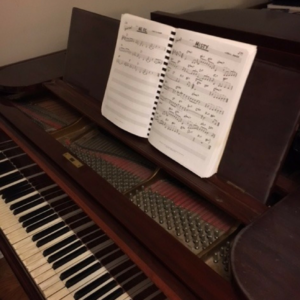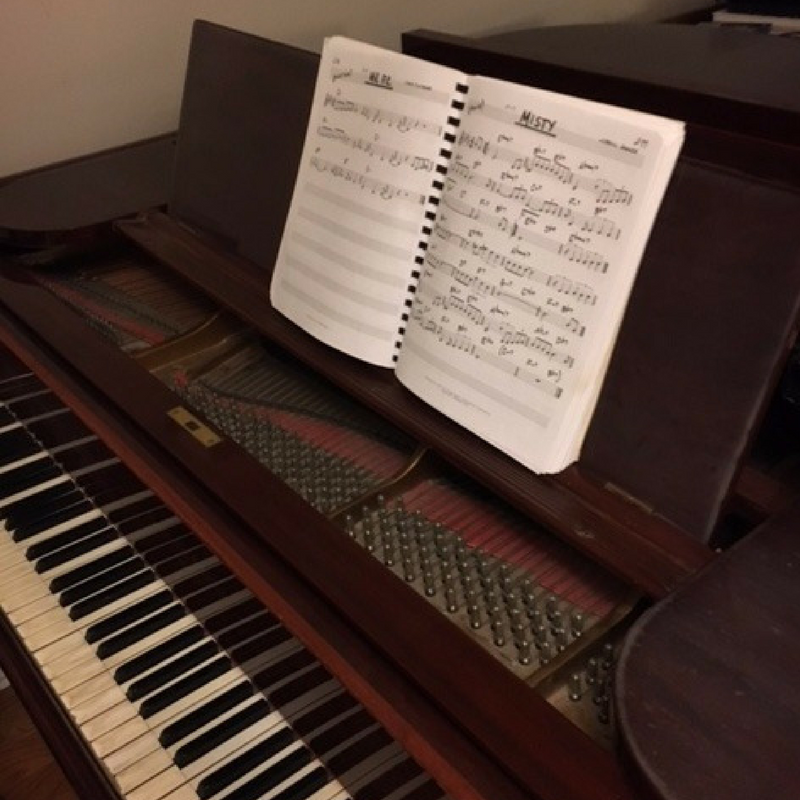
The best thing about teaching and writing this blog is that it continually gets me thinking about how we learn jazz piano. Asking ourselves questions like “What will help me play jazz piano better?” and, on the other hand, “What’s holding me back?” become really important in terms of our musical development. After all, we’d all like “to practice more,” but it’s more helpful to ask ourselves “Why don’t I practice more?” and, even better, “What will help me practice more?” See the difference? By reframing the situation into a question, it becomes positive and can lead to real results. (And happier lives because we get more satisfaction from our musical pursuits.)
For the moment, let’s just focus on one aspect of this:
“What can help me learn jazz tunes better?”
For me the first thing that comes to mind is what a bass player once said to me on a gig. When I was about 24 years old, I was a “regular sub” at The Grand Hyatt hotel in Greenwich, Connecticut. When the steady pianist, Norm Kubrin, couldn’t make it, he’d call me and I’d go down and play. One of the joys of this gig was that I got to meet and play with a lot of older, more experienced, musicians. One of them was a bassist named Russell George. Russell was a very nice man who had recorded with Frank Sinatra and, on electric bass, with a lot of rock and pop artists. (If I remember correctly, he was the bassist on Paul Simon’s big hit “Me And Julio Down B The Schoolyard.)
Anyway, Russell and I had fun playing together and we’d chat during our breaks. One day, he looked at me and said, “You know, Ron, it was so much easier learning jazz tunes when I was young.” He further explained that when we was learning to play jazz, in the 1950’s, he’d hear jazz standards everywhere: on the radio, in Broadway shows, in movies, and in every restaurant and bar he went to since there were live musicians everywhere. At that time, much of the jazz repertoire consisted of jazz versions of pop and show tunes. But as he pointed out, for me, coming up in the 1970’s and 80’s, jazz and pop had drifted apart so that I had to learn the jazz repertoire differently. It wasn’t based on songs that I already could sing by heart, as it was for him when he was learning tunes.
So for, me a big question is: “How can we emulate, as best we can, this more “immersive” way of learning jazz standards?” Well, besides going out and hearing live music when we can, we want to listen to as many recordings of each song as possible, and not just as played by jazz musicians.
This means that yes, we want to hear how a popular singer would have crooned a song like “Misty,” so we can bring a little of that lyricism into our jazz interpretation. After all, jazz greats like Charlie Parker and Sonny Rollins were influenced by vocalists, and not just the ones who were particularly jazzy.
And, of course, we’ll benefit by checking out jazz versions of the tunes as well, just as someone like the young Miles Davis would have heard when we walked into The Royal Roost or another jazz club “back in the day.”
The other thing that will help us is to hear what another musician says about the tune. “Oh yeah, you’ll need to learn this one because everyone plays it,” and “The chords on the bridge in this tune seem tricky, but they’re really just ii/V/I’s in different keys.”
Over the years I’ve thought a lot about Russell George and what he said to me so long ago. And it’s led me to write The Jazz Pianist’s Ultimate Guide To The Real Book. I’m creating one page for every tune in The Real Book, Volume 1, and I’ve just published 16 new pages today. (I started last October and I’m up to #237 out of 400!)
I’m treating each tune just as if I saw you at a piano and wanted to get you started really understanding where each tune came from, with a little overview of the tune and some recordings you should listen to.
Here are the 16 pages I’ve just posted today. By taking a few minutes with each tune here, you’ll give yourself a big “head start” towards learning these jazz standards in a more complete way. A way that will give you a broader understanding of not only how each tune sounds, but where it came from and how to approach it on the piano. (Just click on each title to go to the page.)
The Magician In You
Mahjong
Maiden Voyage
A Man And A Woman
Man In The Green Shirt
Meditation
Memories Of Tomorrow
Michelle
Midnight Mood
Midwestern Nights Dream
Milano
Minority
Miss Ann
Missouri Uncompromised
Mr. P.C.
Misty
Have fun learning about each tune, and good luck with your jazz piano playing!
Learn the 5 Essential Left Hand Techniques with my free ebook: Left Hand Techniques for Jazz Piano
You’ll also get my weekly jazz newsletter with practice tips and inspiration

